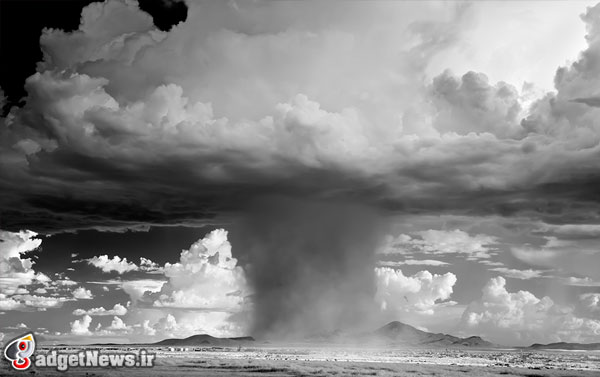
سوپرسل ها طوفانهایی عظیمند که معمولا با گردبادهای بزرگ و ابرهای تیره نمایی خوف انگیز و با ابهت ایجاد می کنند. عکاسی به نام Mitch Dobrowner به همراه راهنمایش از سال ۲۰۰۹ هر تابستان راهی بیابانهای بزرگ امریکا می شود تا به شکار تصاویر این نیروی وحشتناک طبیعت بپردازد و نتیجه این کنجکاوی مجموعه ای از عکس های سیاه و سفید فوق العاده شده که ابهت این طوفانهای خشمناک را به خوبی به تصویر می کشد.
این طوفانهای با عظمت ، همانطور که در این مجموعه عکس خواهید دید صحنه هایی چشمگیر را از طبیعت به نمایش می گذارند اما متاسفانه هر سال خسارات زیادی را برای مردم به بار می آورند و خانه های زیادی را ویران می کنند. البته Dobrowner در این مجموعه صرفا به نمایش ابهت و شکلهای خارق العاده این طوفان پرداخته و این عکسها عموما در مناطق خالی از سکنه گرفته شده اند.
این عکاس که علاقه ای به دیدن ویرانی ها و مشکلات ناشی از این طوفانها علاقه ای ندارد می گوید که می خواهد زیبایی پنهان در این طوفانها را همانطور که خودش درک کرده به دنیا هم نشان دهد. او طوفانها را اینطور توصیف می کند :
“وقتی که طوفانها تازه می خواهند شکل بگیرند درست صحنه ای مانند لحظه تولد ایجاد می شود، و بعد این طوفانها شروع به رشد و بزرگ شدن می کنند و در این مرحله مانند یک نوجوان سرکش و غیر منطقی می شوند. و بعد در طول زمان آنها بالغ می شوند و در پی آن زمانشان تمام شده و می میرند.”
پیدا کردن این طوفانها هم با وجود فناوری های جدید هیچ وقت کار آسانی نیست، Dobrowner و راهنمایش همیشه نیم نگاهی هم به رادارهای مختلف داشته اند تا سر وقت در بهترین نقطه در نزدیکی طوفانها باشند که البته بیشتر اوقات فقط ساعتهای طولانی را به رانندگی در جاده های بیابانی گذرانده اند بدون هیچ نتیجه ای. آنها در یک دوره دو هفته ای بین ۵۰۰۰ تا ۷۰۰۰ مایل مسیر را برای پیدا کردن طوفانها زیر پا می گذارند و این کار ساده ای نیست.
از طرفی با وجود اینکه آنها معمولا به اندازه ای که آسیب نبینند از این طوفانها دورند گاهی هم اتفاقات دیگری رقم می خورد و آنها حسابی توی دردسر می افتند.
با هم نگاهی می اندازیم به تعدادی از این عکسهای شگفت انگیز :
{photo}92/06/27/Supercell{/photo}
منبع : wired
Awe-Inspiring Photos of Swirling Superstorms Belie Their Destructive Power
Supercell thunderstorms are characterized by a cycling, cylindrical vortex of air that moves upward off the ground, which is also known as a mesocyclone. Not only does it sound badass, but it produces some of the most visually striking weather on Earth.
Each summer since 2009, photographer Mitch Dobrowner and guide Roger Hill have driven through the Great Plains and high deserts of the United States in search of these jaw-dropping forces of nature. When they find them, Dobrowner pulls out his camera and takes breathtaking black and white photos that capture the enormity and intensity of these churning atmospheric formations.
“On just the second day I was chasing storms I found myself standing there and I was like, ‘Holy shit, you have to be kidding me,’” Dobrowner says. “I had never seen anything like it.”
Unlike photos that focus on the chaos these storms often leave behind — destroyed houses, uprooted trees — Dobrowner’s images concentrate on the natural beauty of storms themselves as they lumber through unoccupied territory.
“I don’t like to see a lot of destruction or violence. If I want to see that, I can see it on the streets of Los Angeles where I live,” he says. “Out on the plains I can just enjoy the serenity and beauty of the storms. That’s the part that really feeds me.”
In talking about the storms, Dobrowner likes to compare their life cycle to that of a human being.
“When they first form it’s like a birth,” he says. “Then they start to mature and they can become irrational almost like a kid or a teenager. Then, at some point in the formation some storms will become a supercell and will take on a real maturity. But eventually they age out and die, and that can take a couple minutes or a couple hours.”
Finding the storms is hard work, even with modern technology. Dobrowner and Hill keep a close eye on the radar to try and put themselves in the right place at the right time but almost always end up driving for hours.
“I usually go out for two weeks and cover 5,000 to 7,000 miles,” he says. “Five hundred miles is a short day.”
All of Dobrowner’s work is digital because he has to react fast once he’s in the right spot. He’s looking at the overall formation but also trying to capture a moment. Maybe it’s the beginnings of a tornado, a spot of sunlight, or maybe a lightening bolt.
Most of the time Dobrowner and Hill are far away enough that they’re safe. But sometimes things change.
“There have been times where it turns from us chasing the storms to the storm chasing us,” he says.
To really understand what it’s like to stand next to a supercell, he says, you have to be there. But the next best thing is viewing the photos as prints. He says he’d much prefer that people see the images on paper instead of digitally because a print on a gallery wall forces the viewer to pause and take in the work.
 گجت نیوز آخرین اخبار تکنولوژی، علم و خودرو
گجت نیوز آخرین اخبار تکنولوژی، علم و خودرو 





